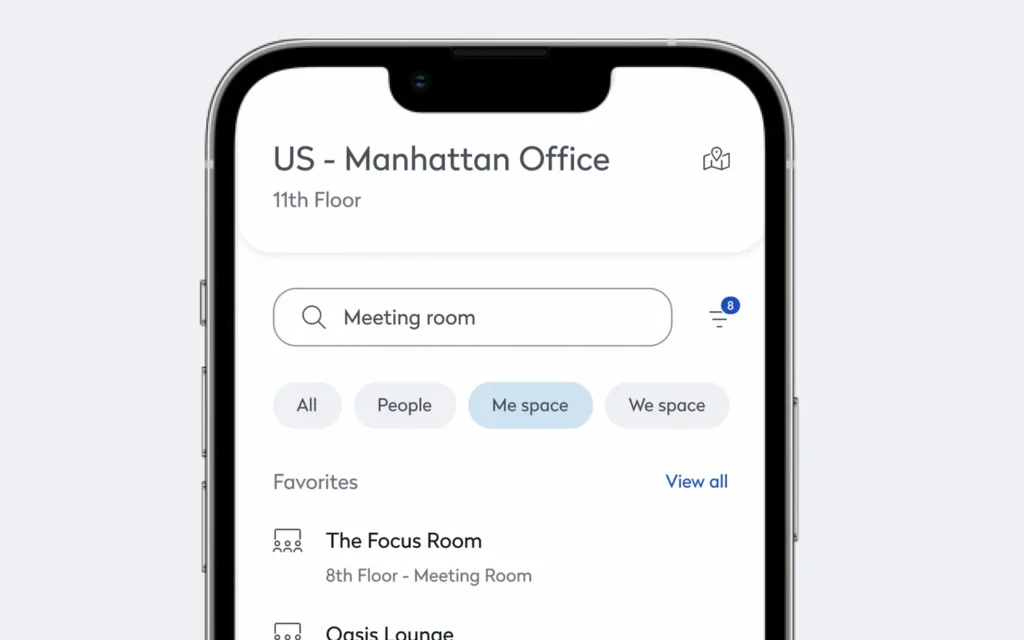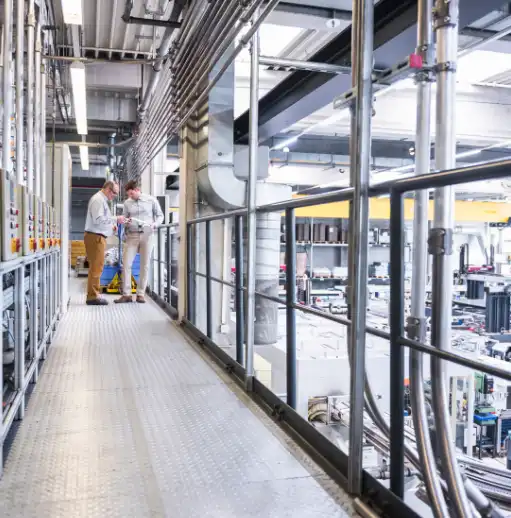
Key takeaways
- Agile working is about flexibility, not just location. It’s an ecosystem of people, spaces, policies, and technology that empowers employees to work where, when, and how they’re most productive.
- Large enterprises benefit from agility at scale. Agile practices improve space efficiency, boost employee engagement, foster collaboration, and integrate seamlessly with hybrid work models.
- Technology is the backbone of agile success. Integrated Workplace Management Software (IWMS) provides the space booking, occupancy tracking, and data insights needed to manage agile environments effectively.
The traditional office layout is no longer the gold standard for productivity and efficiency. Forward-thinking businesses are increasingly recognizing the value of agile working practices, which empower employees to work in ways that best suit their tasks and preferences.
Even as the world shifts towards a more hybrid work model, with employees balancing in-office and remote work, the principles of agile working remain relevant. By addressing employee concerns and creating a supportive environment for agile practices, businesses enable their workforce to be more productive, innovative, and engaged.
What is agile working?
Advanced Workplace Associates, a UK consulting group, has been helping organizations transition to agile working for the past three decades. They define agile working as “a spectrum of working arrangements that enable people to work when, how, and where they like.”
Embracing agile working doesn’t just mean establishing an open-office floor plan or giving employees the option to work remotely. It requires employers to expand their definition of the workplace itself. They must recognize that it’s more than just a physical location — it’s an ecosystem of employees connected by technology.
Successfully transitioning to agile working is fundamentally about good change management. It requires several key elements, including:
- An activity-based workplace design that allows employees to work where they work best
- Agile policies that provide guidance for where, when and how work happens
- Management that supports and builds trust with employees
- Agile workplace technology that makes it easy for employees to work anywhere
An agile work environment is flexible and can be easily adapted to meet the needs of the workforce. Examples of agile working include:
- Activity-based working (ABW): Employees can select from various workspaces (such as private rooms, conference rooms and collaborative areas) and can move freely between them throughout the day.
- Hot desking: Employees choose from a set of unassigned workstations that are available on a first-come, first-serve basis and are encouraged to regularly select different locations to encourage collaboration.
- Hoteling: While similar to hot desking in that employees choose from a pool of available workstations, office hoteling requires employees to reserve a workspace before arriving at the office.
Agile working empowers employees by giving them access to the spaces, policies, and technologies they need to collaborate with their colleagues, no matter where they’re working.
The benefits of agile working for large organizations
Large enterprises face unique challenges in the modern workplace. They need to cater to diverse workforces with varying needs, optimize vast office spaces, and foster innovation and collaboration to stay competitive. Here’s how agile working tackles these challenges and empowers large organizations:
- Enhanced employee productivity and engagement: Agile work environments empower employees to choose the environment that best suits their needs and tasks, leading to increased focus and improved work quality.
- Unlocking innovation and collaboration: Agile practices facilitate collaboration by creating dedicated zones for team interaction and spontaneous meetings. Open spaces and social lounges encourage informal connections between employees, which can spark innovative ideas and problem-solving approaches.
- Attracting and retaining top talent: Today’s workforce prioritizes work-life balance and flexibility. Agile working offers a modern workplace experience featuring choice and control over work environments, contributing to a happier and more engaged workforce.
- Improved space efficiency: Agile working allows companies to utilize their office space more efficiently. By eliminating the need for assigned desks for every employee, companies can create dedicated zones that cater to specific needs and reduce wasted space.
- Enabling a hybrid work model: Agile working practices seamlessly integrate with a hybrid work model. Whether employees are in the office for team meetings or working remotely, they have the tools and resources necessary to stay productive and connected.
Integrated Workplace Management Software (IWMS) as a cornerstone
Implementing agile working effectively in a large enterprise requires careful planning and a robust technological backbone. Integrated Workplace Management Software (IWMS) is a crucial tool in this process.
Here’s how IWMS empowers agile working within large enterprises:
- Space reservation and management: Employees can use IWMS apps to reserve specific workspaces for dedicated tasks, eliminating the frustration of searching for an appropriate space upon arrival at the office.
- Real-time occupancy sensors: IWMS can use sensors to track space utilization in real time, allowing facility managers to monitor trends and optimize the allocation of workspaces based on actual usage.
- Data-driven decision-making: IWMS collects valuable data on space utilization, employee preferences, and meeting patterns. This data can be analyzed to continuously improve the work layout and ensure it effectively caters to evolving employee needs.
- Seamless wayfinding and navigation: for large, multi-floor offices, IWMS can provide mobile app-based wayfinding features to help employees locate available workspaces, meeting rooms, and amenities when they need to.

The workplace beyond agile practices
Agile working is not a static concept; it’s constantly evolving alongside technology and the changing nature of work. As we look towards the future, we can expect to see even more innovative approaches within the agile framework.
Here are some exciting possibilities for the future of agile work environments:
- Activity-based ambients: Emerging technologies like AI and environmental sensors could allow workspaces to adapt to individual needs in real-time. For example, a room could adjust lighting, temperature, and even noise levels based on the task being performed or the preferences of the occupant.
- Biometric integration: IWMS could integrate with biometric technology to personalize the work experience further.
- Advanced collaboration tools: Technology will continue to revolutionize collaboration within agile environments. Virtual reality and augmented reality tools could facilitate remote team collaboration and virtual meetings in a more immersive and engaging way. These technologies can break down physical barriers and create a sense of co-presence, even when team members are in different parts of the world.
Supporting work models with software: a success story
Vodaphone Group
Kellogg’s, a multinational food manufacturer, needed to adapt their work environment to better support more flexible office work models. Kellogg’s collaborated with Eptura to develop a tailored solution that catered to their global workforce spread across 10 offices and involving 2,000 employees.
A rapid rollout was crucial because of Kellogg’s commitment to support in-office operations. The pilot program, which included only 60 employees in Manchester, UK, was a success, paving the way for a broader implementation. Eptura delivered user-friendly web and mobile applications, with an even split in usage between the two platforms. Overall, the system facilitated a smooth transition back to the office and integrated detailed floor plans to manage occupancy and utilization capacities effectively.
Employees embraced the flexibility of the new work arrangements, which was reflected in the overwhelmingly positive feedback from both seasoned and new employees. Soon, the demand for office workstations often exceeded the available supply, proving the system’s success. People wanted to come back to the office.
The project’s success has prompted the company to consider a global expansion of the solution and to rethink their office designs based on real-time demand and analytics.
Looking forward
The future of work is undoubtedly digital, and agile working is a key component of this transformation. By embracing agile practices and leveraging the power of technology, large enterprises can create more dynamic, productive, and employee-centric workplaces. The journey towards a more agile future is ongoing, and it’s essential for organizations to stay adaptable and open to innovation to remain competitive. If you’re one of these organizations, get in touch with Eptura for solutions to create a streamlined workplace.
Frequently asked questions
How is agile working different from hybrid working?
Hybrid working focuses on balancing in-office and remote days, while agile working is a broader approach that gives employees choice and control over how, where, and when they work, whether that’s on-site, remotely, or in different types of workspaces.
Why is IWMS important for agile working in large enterprises?
IWMS consolidates space reservation, occupancy data, wayfinding, and analytics into one platform, helping facility managers optimize layouts, improve space utilization, and support employee flexibility at scale.
What are examples of agile work arrangements?
Common setups include activity-based working (ABW), hot desking, and office hoteling—each offering employees different ways to select and use spaces based on their needs for focus, collaboration, or privacy.
Frequently asked questions
Hybrid working focuses on balancing in-office and remote days, while agile working is a broader approach that gives employees choice and control over how, where, and when they work, whether that’s on-site, remotely, or in different types of workspaces.
IWMS consolidates space reservation, occupancy data, wayfinding, and analytics into one platform, helping facility managers optimize layouts, improve space utilization, and support employee flexibility at scale.
Common setups include activity-based working (ABW), hot desking, and office hoteling—each offering employees different ways to select and use spaces based on their needs for focus, collaboration, or privacy.








